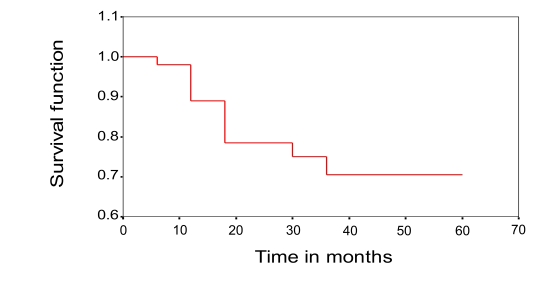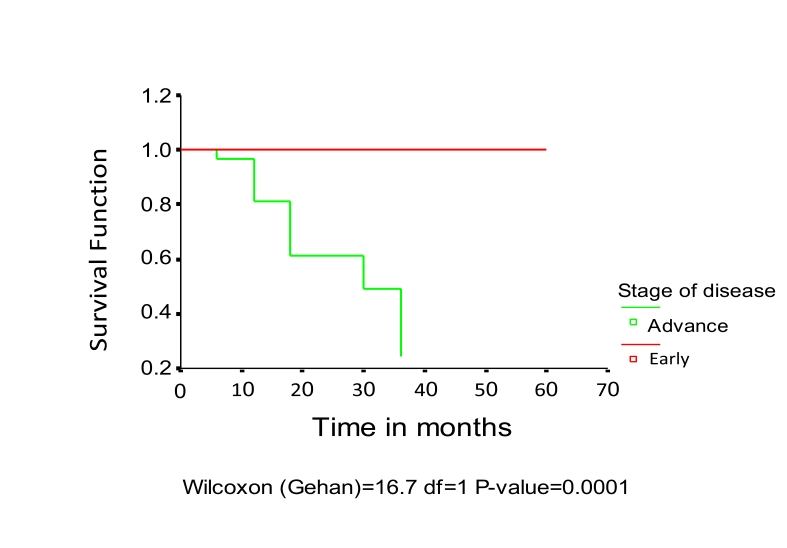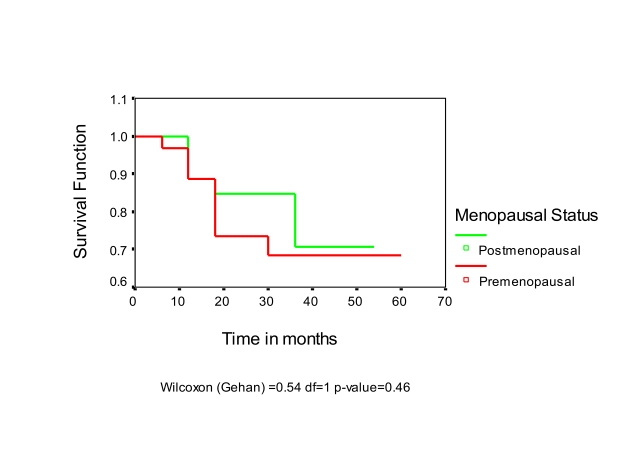Abstract
Objectives
Developing countries are experiencing demographic and epidemiologic transition and the prevalence of non-communicable diseases especially cancers which is on the increase. Breast cancer is the most common and lethal malignancy in developing countries with varying presentation. This study aims to determine the pattern of presentation and survival of breast cancer patients in North Western Nigeria.
Methods
A five-year retrospective review of breast cancer records from 2001-2005 was conducted. Relevant information was retrieved and analyzed using statistical package for social science software. Manchester stage III and IV were classified as advance disease. Survival analysis was carried out with survival defined as the time between the date of commencement of treatment and the date of last follow-up or death.
Results
Most of the patients were in the 4th and 5th decades 58 (57.4%) with a mean age of 44.5±13 years. Majority of the patients were females 99 (96.1%). One of the four males had invasive lobular carcinoma while the others presented with invasive ductal carcinoma 3 (75.0%). Most of the patients were premenopausal 62 (62.6%) and were presented late with advanced breast cancer disease 64 (62.1%). The left breast was more affected 64 (62.1%), and the upper outer quadrant was mostly involved 48 (60.7%), followed by the areola, 43(41.7%) either singly or in combination. Invasive ductal carcinoma was detected in 85 (82.5%) cases and was the predominant histological finding. Survival rate beyond 30 months was observed in 24.5% of cases and 100% for advanced and early breast cancer respectively, (p=0.0001). The overall survival rate beyond 36 months was 70.4% and postmenopausal patients (70.6%) had better survival beyond 36 months than premenopausal (68.5%) patients (p=0.05).
Conclusion
The overall survival rate was low and patients with early breast cancer had better survival than those with advanced disease. Majority of the patients were young premenopausal women with advanced breast cancer.
Introduction
Developing countries are experiencing demographic and epidemiologic transition and the prevalence of non-communicable disease especially cancers which is on the increase.1 The ageing population and gradual decline in mortality has brought about an increasing incidence in non-communicable diseases like cancer of the breast world wide but the outcome of diagnosed and treated cases differs significantly in developed and developing countries.2
Approximately 212,920 new cases of invasive breast cancer, 61,980 in situ cases, and 40,970 deaths were expected to occur among US women in 2006.3 It is estimated that 1 in 8 Caucasian women (1 in 14 African-American) in the US and 1 in 12 in Britain will develop cancer of the breast in their life time.4
The prevalence of breast cancer in Nigeria is unknown but studies in Zaria and other centres showed that it is either the first or second commonest cancer affecting women in this country.5-7 Every 1 in 5 (23%) case of breast mass diagnosed at the Ahmadu Bello University Teaching Hospital (ABUTH) Zaria is malignant in nature.8
In contrast to the developing countries, survival rates for breast cancer in the developed countries have been improving in the last 20 years and more women are being successfully treated than ever before.9 However, Afro-Caribbean women are more likely to be diagnosed with advanced breast cancer.10
The study intends to describe the pattern of presentation and outcome of breast cancer managed at the Ahmadu Bello University Teaching Hospital Zaria, Nigeria.
Methods
The Ahmadu Bello University Teaching Hospital (ABUTH) is a 700-bed Teaching hospital located in Shika, a semi-urban area of Zaria in Kaduna State, Northern Nigeria. It is a centre of excellence for oncology and provides services to patients from all over the country but mainly within the North western region of Nigeria.
This is a descriptive study in nature using retrospective review of existing records from 2001-2005. Histologically confirmed cases of breast cancer that received at least one form of treatment and had at least one follow up visit were included. A total of 103 records met the criteria and were retrieved.
Data was retrieved from the surgery/pathology register and linked with the main central patient records. This was entered and analysed using the statistical package for social science (SPSS Version 11.5) software.
Survival analysis was carried out using the actuarial method and survival time was defined as time from commencement of treatment to death. Survival curves for the estimates were compared with across relevant characteristics using the Wilcoxon (Gehan) test.
Results
Patients were predominantly Hausa speaking females 99 (96.1%) and all were married. The mean age of patients was 44.5±13 years and most 58 (57.4%) were within the age range of 30-49 years. Most patients treated were premenopausal 62 (62.6%) and were presented late with advanced breast cancer disease 64 (62.1%).
Approximately half 48 (46.6%) of the patients were presented with stage III disease, while only 12 (11.7%) had stage I. (Table 1)
Table 1. Frequency distribution of Manchester stage of breast cancer.
| Disease stage | Frequency | Percentage |
|---|---|---|
| I | 12 | 11.7 |
| II | 27 | 26.2 |
| III | 48 | 46.6 |
| IV | 16 | 15.5 |
| Total | 103 | 100.0 |
The cancers affected mostly the left breast 64 (62.1%). The upper outer quadrant of the breast 48 (60.7%) was mostly involved followed by the areola in 43 (41.7%) cases either singly or in combination. Only 11 (14.1%) patients had the whole breast involved and there was no bilateral affectation at presentation.
Invasive ductal carcinoma was the predominantly histological presentation 85 (82.5%) followed by medullary carcinoma 6 (5.8%) and invasive lobular carcinoma 5 (4.9%). (Table 2)
Table 2. Frequency distribution of Histological type of tumour.
| Tumour histology | Frequency | Percentage |
|---|---|---|
| Invasive Ductal Carcinoma | 85 | 82.5 |
| Invasive lobular Carcinoma | 5 | 4.9 |
| Intraductal carcinoma | 3 | 2.9 |
| Medullary carcinoma | 6 | 5.8 |
| Mucinous adenocarcinoma | 1 | 1.0 |
| Carcinoma In-situ | 1 | 1.0 |
| Stromal Sarcoma | 2 | 1.9 |
| Total | 103 | 100.0 |
The overall survival rate beyond 3 years was observed in 70.4% of patients, (Fig. 1). There was no mortality experienced by patients with early breast cancer, contrary to 24.5% probability of survival beyond 30 months in patients with advanced disease (p=0.0001), (Fig. 2). Postmenopausal patients had better survival beyond 36 months (70.6%) compared to premenopausal (68.5%) patients, (p=0.46). (Fig. 3)
Figure 1.
Survival function of breast cancer patient treated at ABUTH Zaria 2001-2005
Figure 2.
Comparison of survival of early and advance breast cancer at ABUTH Zaria 2001-2005
Figure 3.
Comparison of menopusal status of breast cancer patients treated at ABUTH 2001-2005.
Discussion
Breast cancer management has been a major challenge to physicians in developing countries, principally due to the lack of advanced technology and late presentation of patients to the hospital.
The majority of patients affected were Hausa females 99 (96.1%) with a sex ratio of 1:25 and the mean age at presentation was 44.5±13 years with majority in the 4th and 5th decades. The patients were younger and only 4 (3.9%) males constitute the total breast cancer burden which is similar to other hospital based studies in Nigeria.11-13 Most patients were premenopausal 62 (62.6%) which is similar to the findings of 69.0% reported by Anyanwu in Eastern Nigeria14 and 77.3% by Odigie et al. in Zaria.12 The reasons for this early age at onset of breast cancer among black women are poorly understood but could probably be connected to the aggressive nature of the disease.15
This study showed that most (62.1%) of the patients presented with advanced disease commonly with Manchester Stage III 48(46.6%). The findings are similar to several other centres in Nigeria.12,14,16-19 Other researchers are of the opinion that several factors could be responsible for the presentation with advance disease. Principally among them perhaps are incisions by other traditional healers, ignorance, poverty and the aggressive characteristics of breast cancers in black populations.12,15
This study also showed that invasive ductal carcinoma was the most common 85 (82.5%) histological type followed by Medullary carcinoma 6 (5.8%). Although the grading was not specified, other researchers have also found invasive ductal carcinoma occurring most commonly.4,13,14,16 The left breast was mostly affected 57 (62.0%) with the upper outer quadrant mostly involved 48 (61.6%) either singly or in combination with other parts of the breast. This is in contrast to a previous study conducted in this centre where the right breast was reported to be the most commonly affected, but similar to the results reported by Adesunkanmi at Ile-Ife, Nigeria.12,19 The upper outer quadrant is also reported to be commonly involved in African and European studies.4,12,20 This may probably be due to the association of the upper outer quadrant with the axillary tail which is a channel for drainage of lymph to the axillary lymph nodes and may carry micro-metastasis more than the other quadrants of the breast.
The overall survival rate of 70.4% at 36 months is low compared to the survival rate of breast cancer patients managed in developed countries which is 95% and above.3 This poor outcome is similar to that report by Anyanwu in Nnewi, Nigeria.21 This perhaps could be due to late presentation because of ignorance and lack of screening services.
Conclusion
The patients managed are relatively young premenopausal women who were mostly presented with advanced breast cancer.
The overall survival rate was low and survival was better among patient with early breast cancer than those with advanced disease. There is need to improve public enlightenment of breast cancer and set up screening centres to encourage early presentations.
Acknowledgements
The authors reported no conflict of interest and no funding has been received on this work.
References
- 1.Lucas AO, Gilles HM. Non-Communicable Disease: Health in Transition. In Short Textbook of Public Health Medicine for the Tropics. International Students Edition. Arnold publishers 2003; 237-259. [Google Scholar]
- 2.Jemal A, Siegel R, Ward E, Murray T, Xu J, Smigal C, et al. Cancer statistics, 2006. CA Cancer J Clin 2006. Mar-Apr;56(2):106-130 10.3322/canjclin.56.2.106 [DOI] [PubMed] [Google Scholar]
- 3.Smigal C, Jemal A, Ward E, et al. Trend in breast cancer by race and ethnicity: Update 2006. Cancer J clin. 2006; 56:168-183. [DOI] [PubMed]
- 4.Badoe EA, Archampong EO, da Rocha-Afodu JT. The Breast. In Principles and Practice of Surgery including Pathology in the tropics. Third Ed. Ghana Publishing Corporation 2000; 457-477. [Google Scholar]
- 5.Afolayan EA. Five years of cancer registration at Zaria (1992-1996). Niger Postgrad Med J 2004. Sep;11(3):225-229 [PubMed] [Google Scholar]
- 6.Dogo D, Pindiga PU, Yawe T. Pattern of breast lesions in north eastern Nigeria. Tropical J Med Research 2000;3:14-17 [Google Scholar]
- 7.Mandog BM. Obekpa, P.O. Orkar, K.S. Histopathological pattern of breast disease in Jos. Niger Postgrad Med J 1998;5:167-170 [Google Scholar]
- 8.Yusufu LM, Odigie VI, Mohammed A. Breast Masses in Zaria. Ann Afr Med 2003;2:13-16 [Google Scholar]
- 9.Jemal A, Tiwari RC, Murray T, et al. Cancer Statistics. Cancer J Clin 2004;54:8-29 . 10.3322/canjclin.54.1.8 [DOI] [PubMed] [Google Scholar]
- 10.Ghafoor A, Jemal A, Ward E, et al. Trend in breast cancer by race and ethnicity. Cancer J clin 2003; 53:342-355. [DOI] [PubMed]
- 11.Thomas JO. Cancer registration and diagnosis in Ibadan. Archives of Ibadan Medicine 2000;1:5-6 [Google Scholar]
- 12.Odigie VI, Yusufu LM, Rafindadi A, da Rocha-Afodu JT. Breast cancer in Zaria. Nig J Surg 2003;9:46-50 [Google Scholar]
- 13.Ekanem VJ, Aligbe JU. Histopathological types of breast cancer in Nigerian women: a 12-year review (1993-2004). Afr J Reprod Health 2006. Apr;10(1):71-75 10.2307/30032445 [DOI] [PubMed] [Google Scholar]
- 14.Anyanwu SN. Breast cancer in eastern Nigeria: a ten year review. West Afr J Med 2000. Apr-Jun;19(2):120-125 [PubMed] [Google Scholar]
- 15.Chlebowski RT, Chen Z, Anderson GL, Rohan T, Aragaki A, Lane D, et al. Ethnicity and breast cancer: factors influencing differences in incidence and outcome. J Natl Cancer Inst 2005. Mar;97(6):439-448 10.1093/jnci/dji064 [DOI] [PubMed] [Google Scholar]
- 16.Hassan I, Onukak EE, Mabogunje OA. Breast cancer in Zaria, Nigeria. J R Coll Surg Edinb 1992. Jun;37(3):159-161 [PubMed] [Google Scholar]
- 17.Gukas ID, Jennings BA, Mandong BM, Igun GO, Girling AC, Manasseh AN, et al. Clinicopathological features and molecular markers of breast cancer in Jos, Nigeria. West Afr J Med 2005. Jul-Sep;24(3):209-213 [DOI] [PubMed] [Google Scholar]
- 18.Ihekwaba FN. Breast cancer in Nigerian women. Br J Surg 1993;80:126. [DOI] [PubMed] [Google Scholar]
- 19.Adesunkanmi AR, Lawal OO, Adelusola KA, Durosimi MA. The severity, outcome and challenges of breast cancer in Nigeria. Breast 2006. Jun;15(3):399-409 10.1016/j.breast.2005.06.008 [DOI] [PubMed] [Google Scholar]
- 20.Mann CV, Russel RC, Williams NS. Carcinoma of the breast. In Bailey and Love Short Textbook of Surgery. 22nd edition. Arnold Publishers 1999; 553-562. [Google Scholar]
- 21.Anyanwu SN. Survival following treatment of primary breast cancer in eastern Nigeria. East Afr Med J 2000. Oct;77(10):539-543 [PubMed] [Google Scholar]





